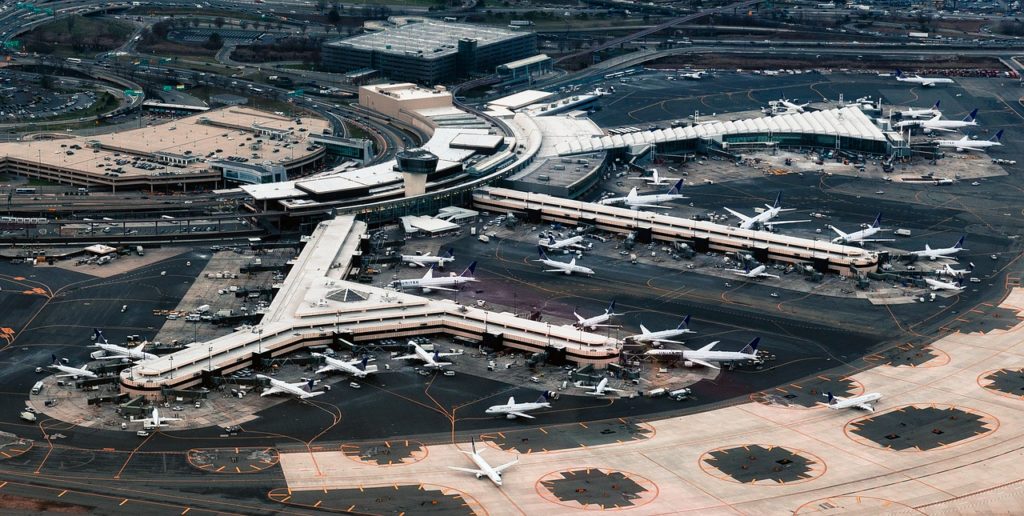In January 2020, as the Coronavirus was starting to spread its tentacles, the US instituted a plan to collect the data of everyone entering the USA. As a part of this plan, everyone was to be put through an on-arrival airport CoVid screening, a very basic one, to collect temperature data and essential health screening via a questionnaire.

Newark EWR
Then, in March 2020, they consolidated the international arrivals from high-risk countries, including China, the Schengen Zone and some other nations, into 15 airports in the US. These airports were:
- Boston-Logan (BOS)
- Chicago O’Hare (ORD)
- Dallas/Fort Worth (DFW)
- Detroit (DTW)
- Honolulu Daniel K. Inouye (HNL)
- Fort Lauderdale-Hollywood (FLL)
- Houston George Bush Intercontinental (IAH)
- Atlanta Hartsfield-Jackson Atlanta (ATL)
- New York John F. Kennedy (JFK)
- Los Angeles (LAX)
- Miami (MIA)
- Newark (EWR)
- San Francisco (SFO)
- Seattle-Tacoma (SEA)
- Washington-Dulles (IAD)
Due to these restrictions, a lot of other airports such as Las Vegas and Philadelphia, which were earlier receiving international flights, were no longer able to do so from countries which were assessed as high-risk in the eyes of the USA. However, the US screening procedures were found wanting, and there was hardly any reasonable attempt to collect data from flyers for effective contact tracing, apart from making a crowd accumulate.
This is the horde of people awaiting health inspections after international flights into @fly2ohare in Chicago. A social-distancing nightmare! (Shared with me by someone in Chicago) pic.twitter.com/hOywwvaWR8
— David Enrich (@davidenrich) March 15, 2020
Now, a press release from the CDC informs us that the US Government has decided to discontinue its enhanced screening of passengers on inbound international flights with effect from Monday, September 14, 2020. The screenings will cease on 00:01 hours on Monday, September 14, 2020. With this closure, it will be tough to contact-trace those who will be on a flight where a Coronavirus infected person may inadvertently travel.
As per the CNN,
A TSA official told CNN that a draft public affairs guidance memo lays out the rationale for ending airport screening: Of the 675,000 passengers screened at 15 airports, fewer than 15 had been identified as having Covid-19.
With the rules never being implemented fully (I travelled to the USA in February, and there was no concern about the CoronaVirus at ORD when I landed there), this is just an illogical policy being repealed. The consequence of this will be that all airports will be able to accept flights into the USA, and some of the airports where airlines such as BA and Lufthansa have had to cancel flights, they would be able to reinstate their schedules.
Of course, we still need to await the official announcement of this move to see if there are any last-minute tweaks there.
What do you make of the policy change of the USA to stop enhanced screening for the CoronaVirus?
Liked our articles and our efforts? Please pay an amount you are comfortable with; an amount you believe is the fair price for the content you have consumed. Please enter an amount in the box below and click on the button to pay; you can use Netbanking, Debit/Credit Cards, UPI, QR codes, or any Wallet to pay. Every contribution helps cover the cost of the content generated for your benefit.
(Important: to receive confirmation and details of your transaction, please enter a valid email address in the pop-up form that will appear after you click the ‘Pay Now’ button. For international transactions, use Paypal to process the transaction.)
We are not putting our articles behind any paywall where you are asked to pay before you read an article. We are asking you to pay after you have read the article if you are satisfied with the quality and our efforts.


Here’s the official CDC release. I still can’t figure out what the new strategy is, as they still don’t seem to require contact information. It would be best if they require a test before getting on the flight. PCR or saliva.
https://www.cdc.gov/media/releases/2020/s-0909-covid-19-entry-strategy-air-passengers.html